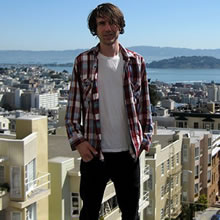ABOUT THIS PROJECT
- Introduction
- The collections
- Stereoscopic photography
- Anaglyphs
- Animated GIFs
- Contribute your collection
- Credits
Feedback, questions, problems? Get in touch at stereo@nypl.org

Joshua Heineman, San Francisco, 2012
Welcome
NYPL Labs is proud to bring you the Stereogranimator, a tool for transforming historical stereographs from The New York Public Library and other participating organizations into shareable 3D web formats. This site is all about your participation, so have fun with it, experiment with it, and let us know how we can improve it. In fact, this project wouldn't even exist if it hadn't been for a user like yourself getting creative with library collections. Here's the story of how that happened…
Introduction by Joshua Heineman
I am told this remarkable application is directly inspired by Reaching for the Out of Reach, my project which ultimately amounts to a 21st century raid of the New York Public Library's archive of 19th century treasure. That is to say, my project was inspired by the library's collection first. This kind of mutually beneficial relationship between archivist & user would have been unthinkable even 10 years ago. So how did we get here?
If you look through enough of old photographs, you might notice that many from before 1900 come in seemingly-identical pairs. What you may not realize is that these pairs were meant to be viewed together, each side lending the other a sense of depth that a photograph alone cannot possess. Using stereoscopes, the entertainment-seeking public of the 19th century immersed themselves in these 3D photographs in a manner akin to how we now view movies, video games or cellphone screens. Do you remember the magic of looking into a ViewMaster as a child & being suddenly somewhere else? You can think of NYPL's stereograph archive as a gold mine of some 40,000 ViewMaster slides, nearly all more than 100 years old - not only somewhere else but some other time!
A small number of public, coin-operated stereo machines survive in antique arcades such as the Musee Mechanique in San Francisco. For most, though, the experience of these photographs as originally intended had been lost to history. The unending computer screen of the Internet itself, while granting unprecedented access to archival materials, seemed to only further distance us from the true dimensions of the stereograph. I must have nearly gone blind viewing the library's collection when I first found it. I knew they were stereo pairs because when I was a child my father had worked with a simple stereoscope in his profession as a forester for the Minnesota Department of Natural Resources & he'd shown me how he used two aerial photographs from slightly different points in the sky to create a three-dimensional birds-eye-view of timber sales. He'd also explained how his stereoscope worked by teaching me how to view stereo pairs without the scope. For viewing the library's collection, the viewing process initially involved loading a fullscreen paired image, setting the laptop on the edge of the bed & then forcing my poor eyes to focus beyond the screen until the resulting double-vision lined up & the middle gained perspective. I spent hours doing this. Even with the difficult viewing process, the effect was startling. The photographs seemed to regain a sense of the moment that we typically do not associate with history. The people & places pictured were still lost, but somehow they felt more real & more alive in their milieu.
Like is often the case, it was dumb luck that changed my private interest into a years-long art project that captivated the Internet (as much as such a thing can happen) & made this NYPL application possible. One evening in my final year of college, I was downloading digital snapshots to my laptop when I got a fleeting sense of 3D as the preview screen flicked quickly between two similar shots. I located the individual photos & flipped back & forth between them continually. The parallax effect of minor changes between the two perspectives created a sustained sense of dimension that approximated the effect of stereo viewing. When I realized how the effect was working, I set about discovering if I could capture the same illusion by layering both sides of an old stereograph in Photoshop & displaying the result as an animated gif. The effect was more jarring than through a stereoscope but no less magic. A few years later, when I started cursivebuildings.com, I quietly began collecting these re-enlivened stereographs from the NYPL archives under the project title Reaching for the Out of Reach. Within a month, there were 70,000 viewers a day pouring over the project, countless links & features, & emails coming in from all over the world - including an encouraging note from a director of the library itself. What can I say? This is my Frankenstein's monster.
Now, thanks to the NYPL Labs team, this is your monster, too. Enjoy.